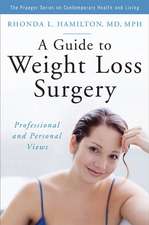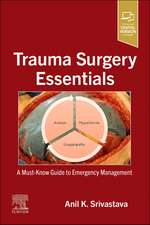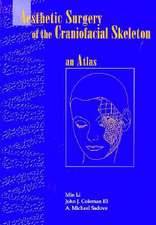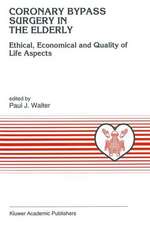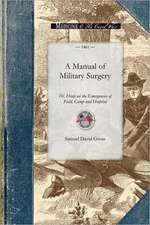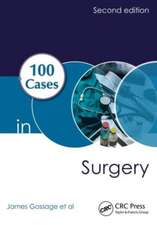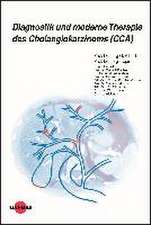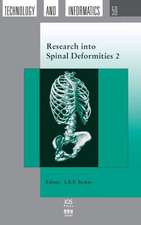Endotherapy in Biliopancreatic Diseases: ERCP Meets EUS: Two Techniques for One Vision
Editat de Massimiliano Mutignani, Jörg G. Albert, Carlo Fabbrien Limba Engleză Paperback – 5 aug 2021
In view of the technical difficulties specific to these techniques, the book also offers access to online-videos and numerous images, making it a valuable resource both for physicians approaching these techniques for the first time as well as for those already using them.
Organized into 7 sections, it describes in detail all techniques related to ERCP/EUS, together with any specific technical equipment required. It also presents a new paradigm based on the latest results in the areas of prevention, diagnosis and management of the most common complications. Clinical outcomes presented in international literature, as well as algorithms – both based on scientific evidence and expert findings – are illustrated and compared to alternative treatments.
Preț: 757.05 lei
Preț vechi: 796.90 lei
-5% Nou
Puncte Express: 1136
Preț estimativ în valută:
144.86€ • 151.65$ • 119.86£
144.86€ • 151.65$ • 119.86£
Carte tipărită la comandă
Livrare economică 02-08 aprilie
Preluare comenzi: 021 569.72.76
Specificații
ISBN-13: 9783030425715
ISBN-10: 3030425711
Pagini: 604
Ilustrații: XIV, 604 p. 285 illus., 180 illus. in color.
Dimensiuni: 178 x 254 mm
Ediția:1st ed. 2020
Editura: Springer International Publishing
Colecția Springer
Locul publicării:Cham, Switzerland
ISBN-10: 3030425711
Pagini: 604
Ilustrații: XIV, 604 p. 285 illus., 180 illus. in color.
Dimensiuni: 178 x 254 mm
Ediția:1st ed. 2020
Editura: Springer International Publishing
Colecția Springer
Locul publicării:Cham, Switzerland
Cuprins
Part 1 ERCP and EUS: armamentarium and surroundings.- 1 ERCP/ERCP Room.- 2 X-rays in endoscopy.- 3 Ultrasound Equipments.- 4 Endoscopes.- 5 ERCP standard and special devices.- 6 EUS Standard Devices.- 7 Deep sedation and anesthesia for advanced gastrointestinal endoscopy: challenging a continuum.- 8 Anatomy Of The Biliary Tree.- 9 Anatomy of the pancreas.- 10 CT: what we need to know to start to interpret radiological pictures.- 11 MR: what we need to know to start to interpret radiological pictures.- 12 Patients management before and after EUS/ERCP.- Part 2 ERCP: WHAT and HOW.- 13 Cannulation techniques.- 14 Biliary sphincterotomy and precut.- 15 Pancreatic Sphincterotomy.- 16 Biliary Stones Extraction.- 17 Intraductal lithotripsy.- 18 Pancreatico-biliary ESWL.- 19 Biliary Stenting.- 20 Endoscopic Papillectomy.- 21 Ductoscopy.- 22 Intraductal Ablation Techniques.- 23 Stent Removal (plastic and metal).- 24 ERCP in altered anatomy.- 25 PTC and PTC-ERCP rendez-vous procedures.- Part 3 EUS: WHAT and HOW.- 26 EUS Diagnostic Puncture.- 27 Ancillary Diagnostic Techniques In EUS.- 28 EUS-Guided Transenteric Pancreatic Duct Drainage.- 29 EUS Assisted Ablation Techniques.- 30 Intraductal US.- Part 4 Complications: prevention, diagnosis and management.- 31 Acute pancreatitis.- 32 Bleeding.- 33 ERCP-related perforations.- 34 Miscellany.- 35 EUS complications.- Part 5 Bilio-pancreatic diseases: clinical results .- 36 Common bile duct stones.- 37 Intrahepatic stones.- 38 Acute Cholangitis.- 39 Papillectomy: clinical results .- 40 TIPS in Malignant Biliary Strictures.- 41 Results Of Eus Transmural Biliary Drainage.- 42 Post-Operative Biliary Stricture.- 43 Biliary complications after liver transplantation.- 44 Biliary Leaks: Role of ERCP in post-operative biliary complications.- 45 Primary sclerosing cholangitis.- 46 Acute cholecystitis.- 47 Acute biliary pancreatitis.- 48 Chronic Pancreatitis.- 49 Pancreatic Fistulas.- Part 6 The cytopathologist’spoint of view.- 50 EUS Tissue sampling : what are we talking about?.- 51 Molecular Biology Of Biliopancreatic Lesions.- Part 7 Clinical Algorithms.- 52 Suspected common bile duct stones (algorithm).- 53 Acute Cholangitis (algorithm).- 54 Diagnosis of etiology in acute pancreatitis.- 55 Periampullary biliary strictures (algorithm).- 56 Hilar Strictures: Algorithm.- 57 Diagnosis of pancreatic cyst: Algorithm.
Notă biografică
Massimiliano Mutignani received his degree in Medicine and Surgery from the Università Cattolica del Sacro Cuore in Rome in 1989. He then completed his first specialization in Emergency General Surgery and Emergency department there in 1994 and obtained a second qualification in Gastroenterology and Digestive Endoscopy in 2003. From 1994 to 2010 he held the annual training course on Clinical General surgery and organized several seminars on liver and biliary Surgery, as well as Digestive Endoscopy. In 2009 he became associate professor of general surgery, and was head of the Gastroenterology and Endoscopy department at the Fatebenefratelli Ophtalmic Hospital for a year. Since 2012, he has been head of the department of Digestive and Interventional Endoscopy at Niguarda Hospital. He has been invited to give lectures on these topics at more than 450 national and international meeting and courses and is the author of 110 publications.
Jörg G. Albert graduated from the Ruprecht-Karl University of Heidelberg and Mannheim Medical School in 2000. He then he worked at the Klinikum of Ludwigshafen and at the Martin-Luther University Hospitals and Clinics in Halle-Witemberg. In 2008 he moved to the department of Internal Medicine at the Johann Wolfgang Goethe University Hospital in Frankfurt and is currently head of Gastroenterology, Hepatology, Endocrinology at the Robert-Bosch-Krankenhaus in Suttgart. He is a member of the American Gastroenterological Association and the European Society Of Gastrointestinal Endoscopy.
Carlo Fabbri is a world renowned endoscopist boarded in both Europe and the United States. His research group is focused on gastrointestinal cancer screening program, endoscopic ultrasonography and interventional endoscopy, and the use of new devices to diagnose and treat biliary and pancreatic diseases. Using the adjunction of both Endoscopic Retrograde Cholangiopancreatography (ERCP) and Endoscopic Ultrasonography (EUS) has permitted successful treatment of newly described procedures that have had a major impact on patient management with obstruction related to cancer. The adjunct use of both Endoscopic Retrograde Cholangiopancreatography (ERCP) and Endoscopic Ultrasonography (EUS) has permitted him and his team to successfully treat pancreatic collections and perform newly described procedures that have had a major impact on patient management.
Jörg G. Albert graduated from the Ruprecht-Karl University of Heidelberg and Mannheim Medical School in 2000. He then he worked at the Klinikum of Ludwigshafen and at the Martin-Luther University Hospitals and Clinics in Halle-Witemberg. In 2008 he moved to the department of Internal Medicine at the Johann Wolfgang Goethe University Hospital in Frankfurt and is currently head of Gastroenterology, Hepatology, Endocrinology at the Robert-Bosch-Krankenhaus in Suttgart. He is a member of the American Gastroenterological Association and the European Society Of Gastrointestinal Endoscopy.
Carlo Fabbri is a world renowned endoscopist boarded in both Europe and the United States. His research group is focused on gastrointestinal cancer screening program, endoscopic ultrasonography and interventional endoscopy, and the use of new devices to diagnose and treat biliary and pancreatic diseases. Using the adjunction of both Endoscopic Retrograde Cholangiopancreatography (ERCP) and Endoscopic Ultrasonography (EUS) has permitted successful treatment of newly described procedures that have had a major impact on patient management with obstruction related to cancer. The adjunct use of both Endoscopic Retrograde Cholangiopancreatography (ERCP) and Endoscopic Ultrasonography (EUS) has permitted him and his team to successfully treat pancreatic collections and perform newly described procedures that have had a major impact on patient management.
Textul de pe ultima copertă
This volume presents the technical and cultural state of the art of two of the riskiest, most complex and operator-dependent digestive operative techniques: endoscopic retrograde cholangiopancreatography (ERCP) and endoscopic ultrasonography (EUS). The authors compare old and new techniques, shedding light on the most recent and innovative scientific findings, including those in the field of anatomic pathology and molecular biology considered relevant for the analysis of tissue samples collected during EUS.
In view of the technical difficulties specific to these techniques, the book also offers access to online-videos and numerous images, making it a valuable resource both for physicians approaching these techniques for the first time as well as for those already using them.
Organized into 7 sections, it describes in detail all techniques related to ERCP/EUS, together with any specific technical equipment required. It also presents a new paradigm based on the latest results in the areas of prevention, diagnosis and management of the most common complications. Clinical outcomes presented in international literature, as well as algorithms – both based on scientific evidence and expert findings – are illustrated and compared to alternative treatments.
In view of the technical difficulties specific to these techniques, the book also offers access to online-videos and numerous images, making it a valuable resource both for physicians approaching these techniques for the first time as well as for those already using them.
Organized into 7 sections, it describes in detail all techniques related to ERCP/EUS, together with any specific technical equipment required. It also presents a new paradigm based on the latest results in the areas of prevention, diagnosis and management of the most common complications. Clinical outcomes presented in international literature, as well as algorithms – both based on scientific evidence and expert findings – are illustrated and compared to alternative treatments.
Caracteristici
Offers a comprehensive guide, both for trainees and specialized doctors, that sets a new benchmark in the field of digestive endoscopic operative techniques Reflects the state of the art as presented by a new generation of experienced European endoscopists and gastroenterologists Illustrates a “new paradigm” based on the latest clinical results and evidence from the field of endoscopic complication management

